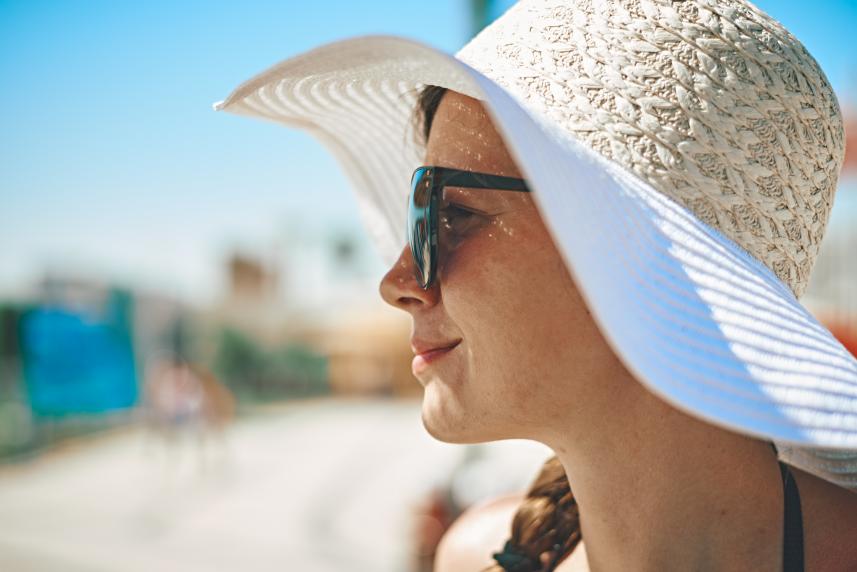
The surprising perks of tinted sunscreen

Yes, it protects your face from sun damage. But it can also do so much more.
Rain or shine, dermatologists agree: You should be wearing sunscreen every day. It’s a key health habit that helps prevent skin cancer and protects against wrinkles. But it’s easy to forget to apply sunscreen to your face before putting on your regular makeup. Or maybe this is a routine you skip entirely because you think it makes your face look greasy.
The solution? Tinted sunscreen.
These formulations typically contain minerals that physically block ultraviolet (UV) rays from penetrating your skin. They contain ingredients such as zinc oxide and titanium dioxide. Tinted sunscreens are ideal for using on your face every day because they feel good and go on smoothly. Even better, they give your skin a subtle glow. Here’s what you need to know. (You can shop for sunscreen products at the Optum Store.)
Why you need to wear sunscreen in the first place
You need to wear sunscreen — no matter what kind you choose — every day to protect your face from the sun’s UV rays. According to the American Academy of Dermatology, sunlight contains 2 types of UV rays that reach the earth: UVA and UVB. (The ozone layer absorbs most UVC rays, so you don’t need to worry about those.)
UVA rays penetrate deep into the skin and are the ones that are primarily associated with wrinkles. UVB rays give us sunburns and play the biggest role in skin cancers. An easy way to remember the difference? “A” for aging, “B” for burning.
Quality sunscreens protect against both UVA and UVB rays. You’ll know because the label will say “broad-spectrum sunscreen,” or it will mention UVA and UVB rays, says Rajani Katta, MD, a board-certified dermatologist in private practice in Houston.
The Optum Store carries a variety of mineral sunscreens to fit your needs.
How visible light and blue light affect your skin
While regular broad-spectrum sunscreens protect against UVA and UVB rays, visible light also affects your skin. That includes sunlight, as well as blue light, which is the kind emitted by your smartphone, TV and computer. Tinted sunscreens can protect against blue light, too.
Visible light penetrates skin more deeply than UVA and UVB light, according to Harvard Health Publishing. It has also been linked to a few skin pigmentation disorders:
-
Melasma. This skin condition is also called “the mask of pregnancy” because it often appears in pregnant women. If you have melasma, you’ll notice brown or blue/gray patches on your face — typically on the cheeks, forehead and upper lip. While these usually fade over time, visible light can cause melasma symptoms to come back.
-
Age spots. Visible light can also speed up the production of melanin in the face, resulting in small dark marks called age spots. Age spots also show up on other areas of the body that have had a lot of sun exposure, such as the backs of your hands, arms and neck. This is a form of hyperpigmentation.
People of color are especially prone to age spots. “They are still at risk from chronic sun exposure,” says Stephanie Cotell, MD, a board-certified dermatologist at Northeast Dermatology and Cosmetic Surgery Center in Gahanna, Ohio.
Blue light from computer screens has also been linked to the breakdown of collagen and elastin fibers in the skin, which could contribute to signs of aging, Dr. Cotell says.
The benefits of tinted sunscreen
One of the biggest perks of tinted sunscreen is that it protects against the rays we can see and those we can’t. Ingredients such as zinc oxide and titanium dioxide work by blocking and scattering the light so that it can’t penetrate your skin.
Tinted sunscreens also feature additional color that’s created by mixing yellow, red and black iron oxides with titanium dioxide to create shades that match just about any skin tone. (Titanium dioxide on its own looks white on the skin.) That adds another layer of protection. As a bonus, it also makes your skin glow.
The skin-tone shade protects skin by reflecting visible light. Some regular sunscreens feature zinc oxide and titanium dioxide that is nanosized, so the formulation doesn’t look so white on the skin. But this process results in particles that can’t block visible light.
How to choose a tinted sunscreen
No matter what your skin tone, you should be using a broad-spectrum sunscreen of at least SPF 30 on your face and body. When choosing a tinted sunscreen, follow these tips:
-
Look for formulas with added vitamins. Some sunscreens feature additional skin-saving ingredients such as vitamin C, vitamin E and hydrating oils. Vitamin C is an antioxidant that limits damage caused by UV light, and vitamin E helps with skin restoration and healing.
-
Pick a formulation for your needs. Mineral sunscreens come in creams, sticks and even powders. “I really home in on that idea of a formulation that works with your lifestyle and activities,” Dr. Katta says. That might mean using a stick on your face before a workout so that it doesn’t run into your eyes, or a gentle cream you can use on your kids’ delicate skin. You might want to try:
-
Creams: The classic when it comes to formulations. It’s easy to rub in.
-
Sticks: One product that can often be used on the face, body, lips, ears and more.
-
Powders: “I have female patients who like a powder because you can apply it with a brush,” Dr. Katta says.
-
-
Don’t neglect your lips. Lips can get sunburned, too. A tinted mineral lip balm with SPF 30 will moisturize and protect, while also adding a bit of glamour.
Choosing the perfect tinted sunscreen means finding one that’s right for your lifestyle. Choose a reliable cream for your face and body, or mix and match several formulations to suit your needs.

Additional sources
Visible light: Harvard Health Publishing (2020). “Tinted sunscreens: Benefits beyond an attractive glow”
Different UV rays: American Academy of Dermatology (2022). “Sunscreen FAQs”
Melasma overview: Cleveland Clinic (2020). “Melasma”
Age spots overview: Cleveland Clinic (2019). “Age spots”
